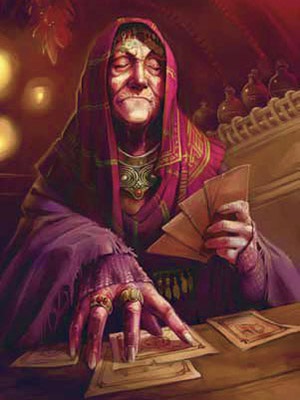GM Tips Our series to help Storytellers and Game Masters improve their craft and create memorable roleplaying experiences. Last week, introduced larger casts of NPC’s to your players and today we will talk about fortune telling.
To say that Tarot has a history is a bit of an understatement. Given the superstition, mysticism, or legend behind the power of a tarot spread, it’s no wonder that it would permeate its way into our roleplaying games as it does in real life. From Vistani travelers in Faerun to the Mage: The Ascension Tarot deck, there is already a precedent for using the cards to both enhance immersion or inspire storytellers.
So how do you use a semi-taboo, or superstitious tool in your game without reverting back to the heyday of Dungeons and Dragons Satanic Panic scare? Well, for starters you dedicate your deck strictly to the game you are running, but more on that later…

Tarot For Side Scenes
The storyteller should set the scene first: A group of bandits are chasing your party through the crowded streets.
Starting with the storyteller, pull out a single tarot card from the deck and see what inspires you in the image. Go ahead and narrate what happens in the inverted seven of cups that’s relevant to the scene, ignoring any dice mechanics or other rules. When you’re done, pass the deck to the next player and let them draw and add to the story as it unfolds. Each player, in turn, acts as their own storyteller, letting the tarot deck guide the scene to resolution rather than the sheets.
Adding this method into your existing game for mood-intensive side scenes, or when you would rather focus on the character than the stats, quiets the room and creates a bond between player and character. I find this works really well if you are side questing or you had a player down and don’t want to continue the main event without the missing party member. This is also a fantastic way to handle flashback or foretelling scenes where the characters stats may have changed, but you don’t want to go through the burden of building multiple sheets. If you have the group that excels at collaborative storytelling this is also a great way as a campaign prelude or backstory building for all characters involved.
Major Arcana Favors
This is a method I use heavily in my 7th Age tabletop games regardless of what system I use, so it’s near and dear to my heart. I’m rather proud of my worlds Pantheon and there are times when I feel the players have earned a particular boon from a demigod or even powerful archmage level character. Not just as quest rewards, but sometimes for even little things such as paying tribute at an inconvenient time. For each of the Major Arcana I’ve assigned a major NPC or God in my world; when the party earns the boon, I give them the physical card.
At any point in time, during any scene, or interrupting any action the players can grab the card and hand it back for a bonus. In some cases, I almost run them like Final Fantasy summons, showing up to the battlefield and creating an epic cutscene that changes the landscape. Other times the effect is more subtle, like offering the party advantage on dice rolls or a random encounter that plays in their favor. Adding an element of this into your game, particularly with deific level NPCs, increases their importance to the players and gives them more agency in how these entities affect the world around their characters.

Dedicate Your Deck
It is considered extremely poor form and bad luck to use a real Tarot deck for fictional role play, and really, why take the risk? Buy yourself a tarot deck specifically for the campaign, and as the storyteller use it for all kinds of things—do pulls to decide random encounters, or full spreads for writing your campaign. When using random generation charts, instead of rolling dice, go ahead and pull from the deck. Not only will you get your random number, but the card itself can provide you with added inspiration to your writing and how it ties to the beholder in the dungeon.
After a long campaign, the deck will become a part of the game, for both you and your players and at the campaign close it serves as a physical reminder. I have multiple tarot decks for various campaigns stored on my shelf to this day, and sometimes, I go back to them for inspiration when players revisit that particular area in my world.
Have you used Tarot decks to enhance your games before? Tell us what became of your fortunes in the comments below!
Looking for More Useful GM Tips?
- GMs: Introduce Large NPC Casts Without Boring Your Players To Death
- How Age of Sigmar can inspire Game Masters
- What D&D Players and GMs Need to Know About Ravnica
Featured Image by: Critical Role Tarot Deck by @IoanaMuresanArt
Image Credits: Madam Eva from Curse of Strahd by Wizards of the Coast, Mage: The Ascension Tarot deck by White Wolf
Rick Heinz is the author of The Seventh Age: Dawn, and a storyteller with a focus on LARPs, Wraith: The Oblivion, Eclipse Phase, and many more. You can follow game or urban fantasy related thingies on Twitter or Facebook.